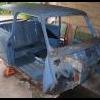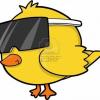Before buying new, try a few additional tests and perhaps refurbish the starter motor.
Remove the starter motor from the car. (Do not forget to disconnect the battery cable in the boot first).
Clean the mounting surface for the starter motor both on the engine and the flange of the motor itself. Remove all corrosion and paint from the mounting surfaces.
Test the motor out of the car using jumper cables directly to your new battery.
Connect the battery (-) terminal to the starter motor flange using one jumper cable wire.
Connect the battery (+) terminal to the remaining jumper cable wire.
Step on the motor to hold it to the ground.
TAP (then hold) the free end of the (+) jumper cable lead against the threaded terminal on the motor.
(There will be sparks and the motor will try and move out from under your foot).
The motor should spin freely and quickly if it is in good order. If the motor is slow and jerky, you may want to try partial disassembly, cleaning and re-oiling the motor bushings. If you disassemble the motor to clean and lubricate it, also check the condition of the copper commutator and the brushes. Clean them as necessary. The copper commutator can be lightly sanded with sandpaper to remove oxidation and contamination. Spray contact cleaner (or even brake cleaner) can be used to flush grease and carbon dust from the brushes.



















